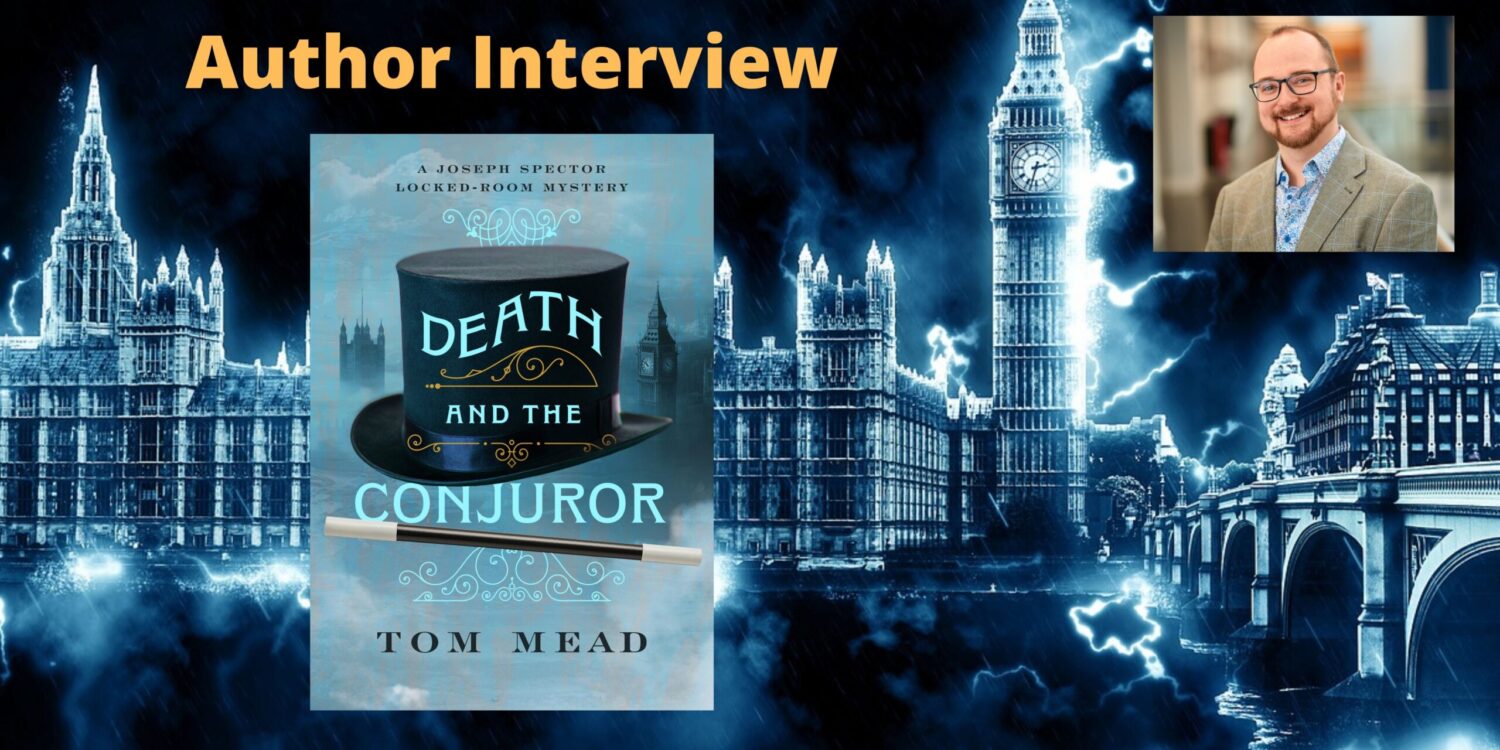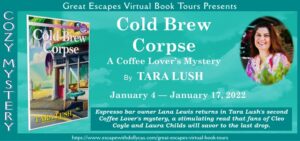Death and the Conjuror, a debut filled with magic and mystery.
Author Interview + Book & Author Info + Author Pet Corner!
Don’t miss Tom’s guest post on my blog with his Partners in Crime Book Tour! Click the link here.
Death and the Conjuror
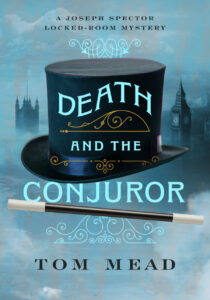 A magician-turned-sleuth in pre-war London solves three impossible crimes
A magician-turned-sleuth in pre-war London solves three impossible crimes
In 1930s London, celebrity psychiatrist Anselm Rees is discovered dead in his locked study, and there seems to be no way that a killer could have escaped unseen. There are no clues, no witnesses, and no evidence of the murder weapon. Stumped by the confounding scene, the Scotland Yard detective on the case calls on retired stage magician-turned-part-time sleuth Joseph Spector. For who better to make sense of the impossible than one who traffics in illusions?
Spector has a knack for explaining the inexplicable, but even he finds that there is more to this mystery than meets the eye. As he and the Inspector interview the colorful cast of suspects among the psychiatrist’s patients and household, they uncover no shortage of dark secrets―or motives for murder. When the investigation dovetails into that of an apparently-impossible theft, the detectives consider the possibility that the two transgressions are related. And when a second murder occurs, this time in an impenetrable elevator, they realize that the crime wave will become even more deadly unless they can catch the culprit soon.
A tribute to the classic golden-age whodunnit, when crime fiction was a battle of wits between writer and reader, Death and the Conjuror joins its macabre atmosphere, period detail, and vividly-drawn characters with a meticulously-constructed fair play puzzle. Its baffling plot will enthrall readers of mystery icons such as Agatha Christie and John Dickson Carr, modern masters like Anthony Horowitz and Elly Griffiths, or anyone who appreciates a good mystery.
To purchase Death and the Conjuror, click on any of the following links: Amazon | Barnes & Noble | Goodreads | The Mysterious Bookshop
The Interview with Tom Mead — Author of Death and the Conjuror
Death and the Conjuror is a locked room mystery. Tell readers what that means and why that intrigued you for your debut novel.
Well, the locked-room mystery is a subgenre of the classic fair-play puzzle mystery.
It’s perfect for fans of Agatha Christie, Ellery Queen, and all those other legends from the first half of the twentieth century. It’s a kind of umbrella term which covers all manner of impossible crimes—that is, crimes where there appears to be no way the criminal could actually have committed them.
The classic example is the murder victim found in a room which is locked or sealed on the inside—the question is not only whodunit but also howdunit? It’s a real challenge for the writer, but a fun one; I love devising problems and then coming up with a logical solution where everything is explained.
One of my favourite books in the genre is The Hollow Man (also published as The Three Coffins) by John Dickson Carr. Carr is a hero of mine, and a constant inspiration—I’m in awe of his ingenuity, imagination, and his knack for creating a spooky, macabre atmosphere.
Death and the Conjuror is set in the 1930s. What do you love about that time period? What research did you do to capture London between the world wars?
It seemed natural to write about the 1930s because that was the height of the golden age of detective fiction.
I thought it was fitting to set my novel—which pays conscious tribute to the genre—right in the middle of its most productive period. So I suppose you could say that the London I’m writing about is seen through the lens of the golden age.
Classic mysteries are fascinating social documents, crammed with insights about class, domestic life, culture, police procedure … you name it!
In terms of research, I came up with the idea for the novel first, then wrote it out in draft, before going on a lengthy research binge where I listed all my questions about whether a specific trick would work or whether a certain scenario would have been feasible in the ’30s. I managed to find most of my answers in books, online archives and old newspapers. The research itself was a pleasure; I always love it when I get the chance to play detective in real life!
How does magic play a role in your debut novel?
My detective character, Joseph Spector, is a retired music hall magician with a knack for solving apparently insoluble problems.
I love writing about him because it gives me the chance to include all kinds of unusual little tricks and sleights-of-hand. But on a broader level, I think there’s an important correlation between mystery writing and illusion. In both instances the “performer” has to ensure the audience is looking in the wrong direction, so they don’t spot how the trick is worked.
This is particularly relevant to locked-room mysteries, where working out how a crime was committed is a key part of the puzzle.
In addition to novels, you also write short stories. How does your process differ between the two?
Again, I think of it in terms of magic tricks. If a novel is like a full-scale magic show, then a short story is like a game of three-card monte.
It might not have all the bells and whistles, but it’s equally challenging in its own way.
In some ways it’s more challenging because you have fewer words to play with, so it’s not as easy to plant clues and guide the reader up the garden path. But the process itself is actually pretty similar—in my case, I might begin a short story with a single puzzle, image, idea or character, whereas I will begin a novel with a few disparate elements that I gradually weave together.
What can we find you doing when you aren’t writing and reading mysteries?
I’m a huge fan of live theatre—everything from experimental drama to musicals. Death and the Conjuror features a fictional West End theatre called the Pomegranate, which gave me the opportunity to delve into the history of London’s famous theatre district. I had great fun basing certain characters on real-life historical figures, and hopefully eagle-eyed readers will be able to work out who’s who.
What are you working on now?
I recently finished the second Spector book, a sequel to Death and the Conjuror called The Murder Wheel.
There’s plenty more magic and mystery for my detective to tackle in the streets of 1930s London!
I’ve also recently finished co-authoring a locked-room mystery for young adults with my friend Michael Dahl, which we’re hoping will be the start of a new series.
Words of Wisdom for Aspiring Writers:
The most important thing is to finish what you start.
No one is going to buy a half-finished novel. You may not get it right first time, but it’s best to tell your story from beginning to end and worry about the rest later. That’s what editing is for.
Author Pet Corner!

This is Chloe. It seems fitting for a mystery writer to have a master thief as a pet. She steals anything she can get her paws round—edible and otherwise.
Her most audacious theft was a peach from a fruit bowl; I found it later that day, half-eaten.
She’s also my muse, and a budding author herself—by which I mean she tends to wander across the keyboard when I’m in the middle of typing a sentenfdg;jjjjjjjjjjjjjjjjjjjjjjjjjjjjjjjjjjjjjjjjj
Tom Mead
 Tom Mead is a UK crime fiction author specialising in locked-room mysteries. He is a member of the Crime Writers’ Association, International Thriller Writers, and the Society of Authors.
Tom Mead is a UK crime fiction author specialising in locked-room mysteries. He is a member of the Crime Writers’ Association, International Thriller Writers, and the Society of Authors.
He is a prolific author of short fiction, and recently his story “Heatwave” was included in THE BEST MYSTERY STORIES OF THE YEAR 2021, edited by Lee Child. DEATH AND THE CONJUROR is his first novel.
To learn more about Tom, click on any of the following links: TomMeadAuthor.com, Goodreads, BookBub, Twitter – @TomMeadAuthor & Facebook – @tommeadauthor
Elena Taylor/Elena Hartwell
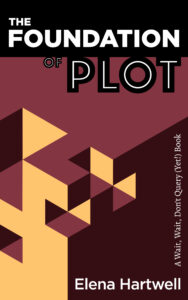 All We Buried, available now in print, e-book, and audio.
All We Buried, available now in print, e-book, and audio.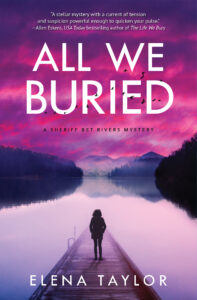
Silver Falchion Award Finalist, Best Investigator 2020
Foreword INDIE Award Finalist, Best Mystery 2020
The Foundation of Plot, a Wait, Wait, Don’t Query (Yet!). Out July 19.
Header photo by The Digital Artist on Pixabay.

